A Numerical Study on Swirling Hot Air Anti-Icing with Various Surface Structures on the Internal Wall
Abstract
1. Introduction
2. Numerical Setups
3. Data Validations
4. Results and Discussions
4.1. Influence of Jet Numbers
4.2. Heat Transfer Characteristics with Surface Structures
4.3. Pressure Loss Characteristics with Surface Structures
4.4. Swirl Intensity
5. Summary and Conclusions
- (1)
- The number and spacing of the tangential inlet jet have a significant influence on the heat transfer performance of the swirling flow. As the jet number increases from three to nine, the averaged Nusselt number decreases, and the heat transfer uniformity is obviously improved.
- (2)
- The surface dimples and bulges are conducive to improving the Nusselt number on the swirl tube wall; however, placing trenches and ribs shows Nusselt number deterioration relative to the smooth swirl tube. With a smaller jet spacing and more jet injections, the effect of surface structures tends to be more positive.
- (3)
- Correspondingly, the surface trenches, dimples and bulges cause reductions in the pressure loss, while the surface ribs lead to a pressure loss increment. The higher the jet number is, the smaller the reduction in the pressure loss caused by the trenches, dimples and bulges will be and the greater the pressure loss augmentation led by the ribs will be.
- (4)
- Among the four investigated surface structures, the surface bulge is the one with the best heat transfer and pressure loss performance in the swirling air anti-icing configuration. The surface bulge could enhance the averaged Nusselt number by 4.0–15.0%, increase the total heat transfer quantity by up to 17.3% and reduce the hot air pressure loss by 8.6–15.6%. This shows significance for improving the performance and efficiency of the hot air anti-icing system.
- (5)
- The circumferential velocity and swirl number are introduced to describe the flow fields and reveal the flow mechanism. The trenches and ribs have little influence on the circumferential velocity distribution and lead to less of a reduction in the swirl intensity. However, the surface dimples and bulges significantly suppress the swirl intensity by up to about 40.8%.
Author Contributions
Funding
Data Availability Statement
Conflicts of Interest
References
- European Aeronautics. A Vision for 2020, Report of the Group of Personalities; European Aeronautics: Stockholm, Sweden, 2001. [Google Scholar]
- Steering Committee for the Decadal Survey of Civil Aeronautics. Decadal Survey of Civil Aeronautics: Foundation for the Future; The National Academics Press: Washington, DC, USA, 2006. [Google Scholar]
- Heinrich, A.; Ross, R.; Zumwalt, G.; Provorse, J.; Padmanabhan, V. Aircraft Icing Handbook Volume 1, AD-A238039; Department of Transportation Federal Aviation Administration: Washington, DC, USA, 1991. [Google Scholar]
- Kreith, F.; Margolis, D. Heat transfer and friction in turbulent vortex flow. Appl. Sci. Res. 1959, 8, 457–473. [Google Scholar] [CrossRef]
- Qian, C.; Flannery, K.; Saito, K.; Downs, J.P.; Soechting, F.O. Innovative vortex cooling concept and its application to turbine airfoil trailing edge cooling design. In Proceedings of the 33rd Joint Propulsion Conference and Exhibit, Seattle, WA, USA, 6–9 July 1997. Paper No. 97-3013. [Google Scholar]
- Blum, H.A.; Oliver, L.R. Heat transfer in a decaying vortex system. ASME 1966. ASME Paper GT1966-WA/HT-62. [Google Scholar]
- Chang, F.; Dhir, V.K. Turbulent flow field in tangentially injected swirl flows in tubes. Int. J. Heat Fluid Flow 1994, 15, 346–356. [Google Scholar] [CrossRef]
- Du, C.H.; Li, L.; Wu, X. Effect of jet nozzle geometry on flow and heat transfer performance of vortex cooling for gas turbine blade leading edge. Appl. Therm. Eng. 2016, 93, 1020–1032. [Google Scholar] [CrossRef]
- Du, C.H.; Li, L.; Chen, X.X. Numerical study on effects of jet nozzle angle and number on vortex cooling behavior for gas turbine blade leading edge. ASME 2016. ASME Paper GT2016-57390. [Google Scholar]
- Mousavi, S.M.; Ghadimi, B.; Kowsary, F. Numerical study on the effects of multiple inlet slot configurations on swirl cooling of a gas turbine blade leading edge. Int. Commun. Heat Mass Transf. 2018, 90, 34–43. [Google Scholar] [CrossRef]
- Hwang, J.J.; Cheng, C.S. Augmented heat transfer in a triangular duct by using multiple swirling jets. J. Heat Transf. 1999, 121, 683–690. [Google Scholar] [CrossRef]
- Hay, N.; West, P.D. Heat transfer in free swirling flow in a pipe. Int. J. Heat Transf. 1975, 97, 411–416. [Google Scholar] [CrossRef]
- Glezer, B.; Moon, H.K.; Kerrebrock, J.; Bons, J.; Guenette, G. Heat transfer in a rotating radial channel with swirling internal flow. ASME 1998. ASME Paper 98-GT-214. [Google Scholar]
- Hedlund, C.R.; Ligrani, P.M.; Moon, H.K.; Glezer, B. Heat transfer and flow phenomena in a swirl chamber simulating turbine blade internal cooling. ASME J. Turbomach. 1999, 121, 804–813. [Google Scholar] [CrossRef]
- Rao, Y.; Biegger, C.; Weigand, B. Heat transfer and pressure loss in swirl tubes with one and multiple tangential jets pertinent to as turbine internal cooling. Int. J. Heat Mass Transf. 2017, 106, 1356–1367. [Google Scholar] [CrossRef]
- Biegger, C.; Weigand, B. Flow and heat transfer measurements in a swirl chamber with different outlet geometries. Exp. Fluids 2015, 56, 78–88. [Google Scholar] [CrossRef]
- Bruschewski, M.; Grundmann, S.; Schiffer, H.P. Considerations for the design of swirl chambers for the cyclone cooling of turbine blades and for other applications with high swirl intensity. Int. J. Heat Fluid Flow 2020, 86, 108670. [Google Scholar] [CrossRef]
- Biegger, C.; Sotgiu, C.; Weigand, B. Numerical investigation of flow and heat transfer in a swirl tube. Int. J. Therm. Sci. 2015, 96, 319–330. [Google Scholar] [CrossRef]
- Kusterer, K.; Lin, G.; Bohn, D.; Sugimoto, T.; Tanaka, R.; Kazari, M. Heat transfer enhancement for gas turbine internal cooling by application of double swirl cooling chambers. ASME 2013. ASME Paper GT2013-94774. [Google Scholar]
- Kusterer, K.; Lin, G.; Sugimoto, T.; Bohn, D.; Tanaka, R.; Kazari, M. Novel gas turbine blade leading edge cooling configuration using advanced double swirl chambers. ASME 2015. ASME Paper GT2015-42400. [Google Scholar]
- Liu, G.W.; Zhang, L.; Guo, T. A review of heat transfer enhancement with dimpled surface. J. Aerosp. Power 2007, 22, 1785–1791. [Google Scholar]
- Rao, Y.; Zhang, P.; Xu, Y.M. Experimental study and numerical analysis of heat transfer enhancement and turbulent flow over shallowly dimpled channel surfaces. Int. J. Heat Mass Transf. 2020, 160, 120195. [Google Scholar] [CrossRef]
- Rao, Y.; Zhang, P. Experimental Study of Heat Transfer and Pressure Loss in Channels with Miniature V Rib-Dimple Hybrid Structure. Heat Transf. Eng. 2019, 38, 1–11. [Google Scholar] [CrossRef]
- Burgess, N.K.; Ligrani, P.M. Effects of dimple depth on channel Nusselt numbers and friction factors. ASME J. Heat Transf. 2006, 127, 839–847. [Google Scholar] [CrossRef]
- Launder, B.E.; Spalding, D.B. The Numerical Computation of Turbulent Flows. Comput. Methods Appl. Mech. Eng. 1974, 3, 269–289. [Google Scholar] [CrossRef]

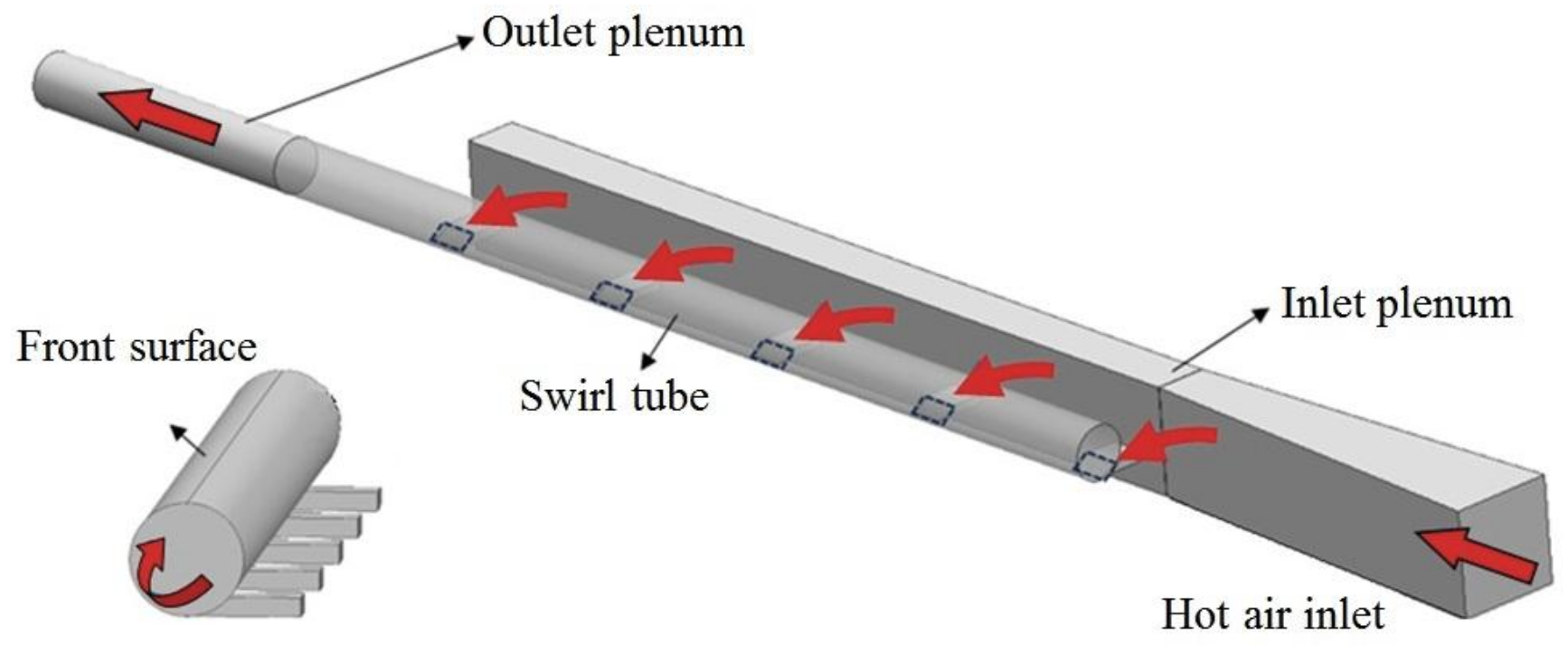
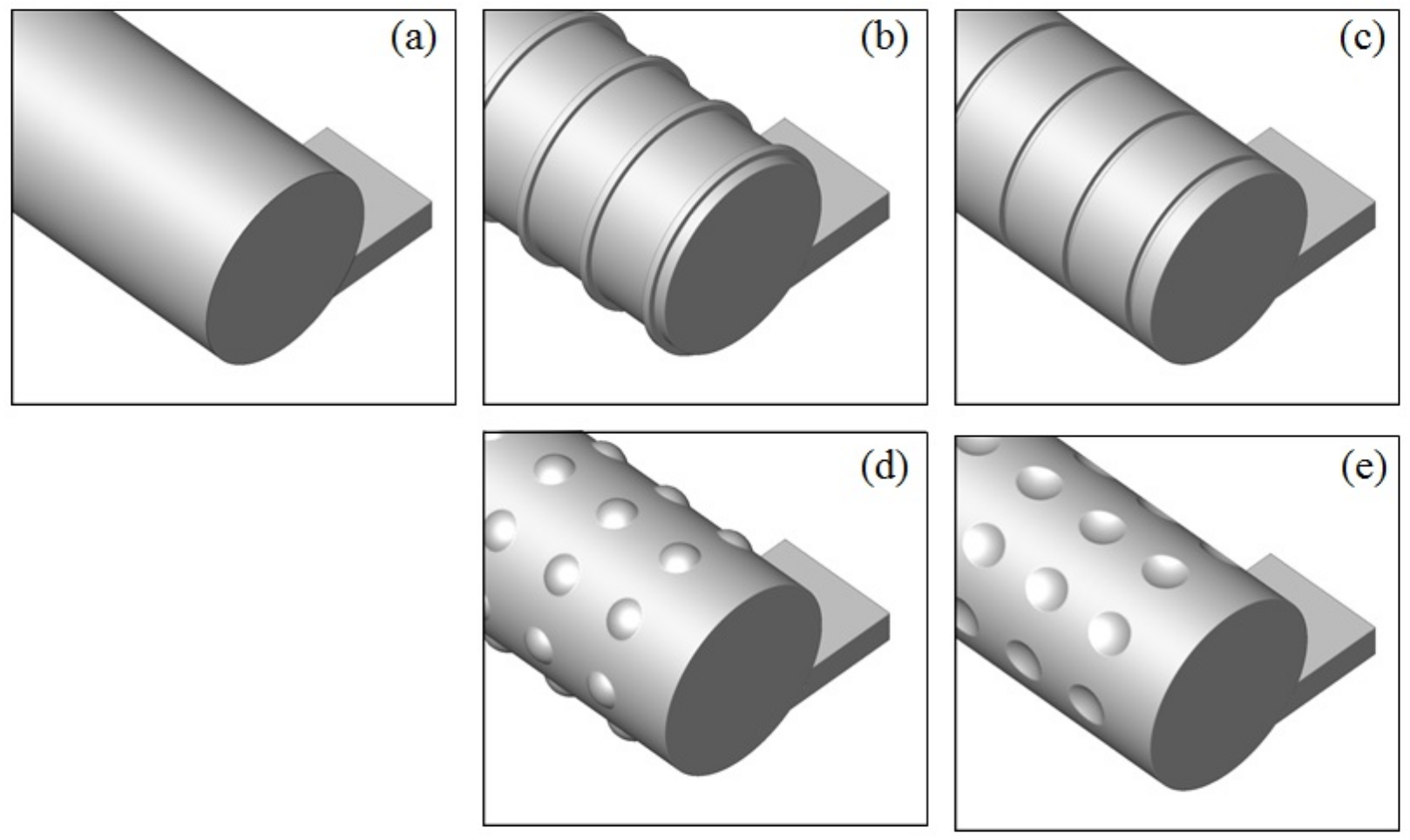
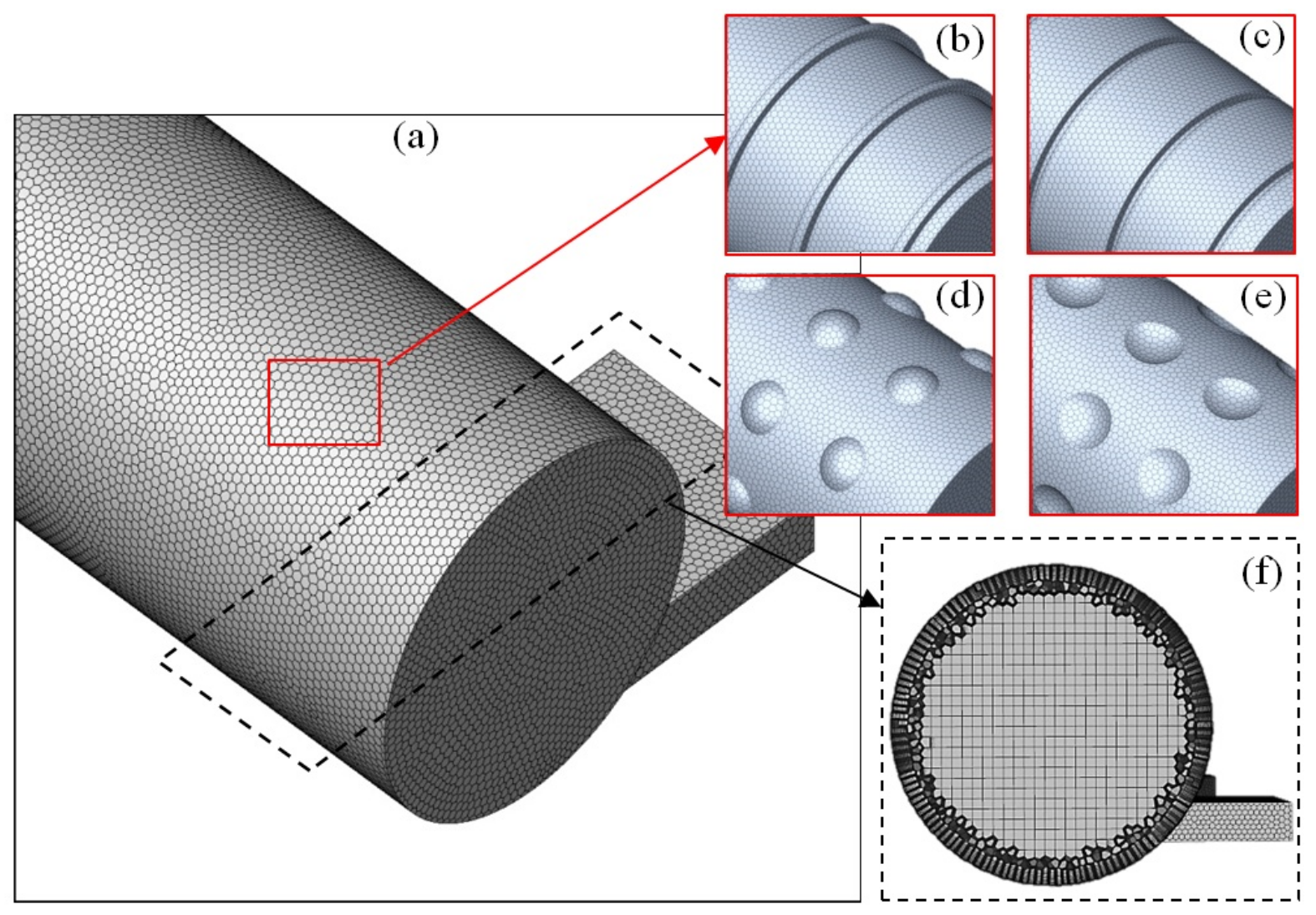
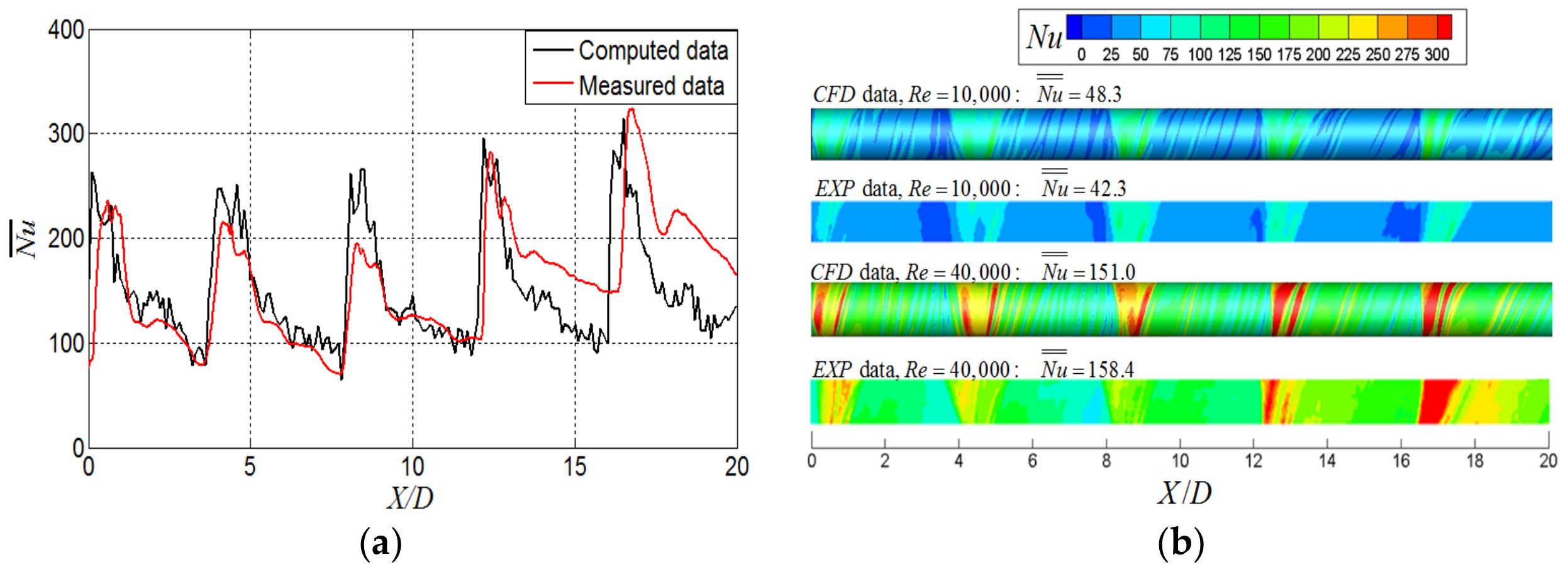
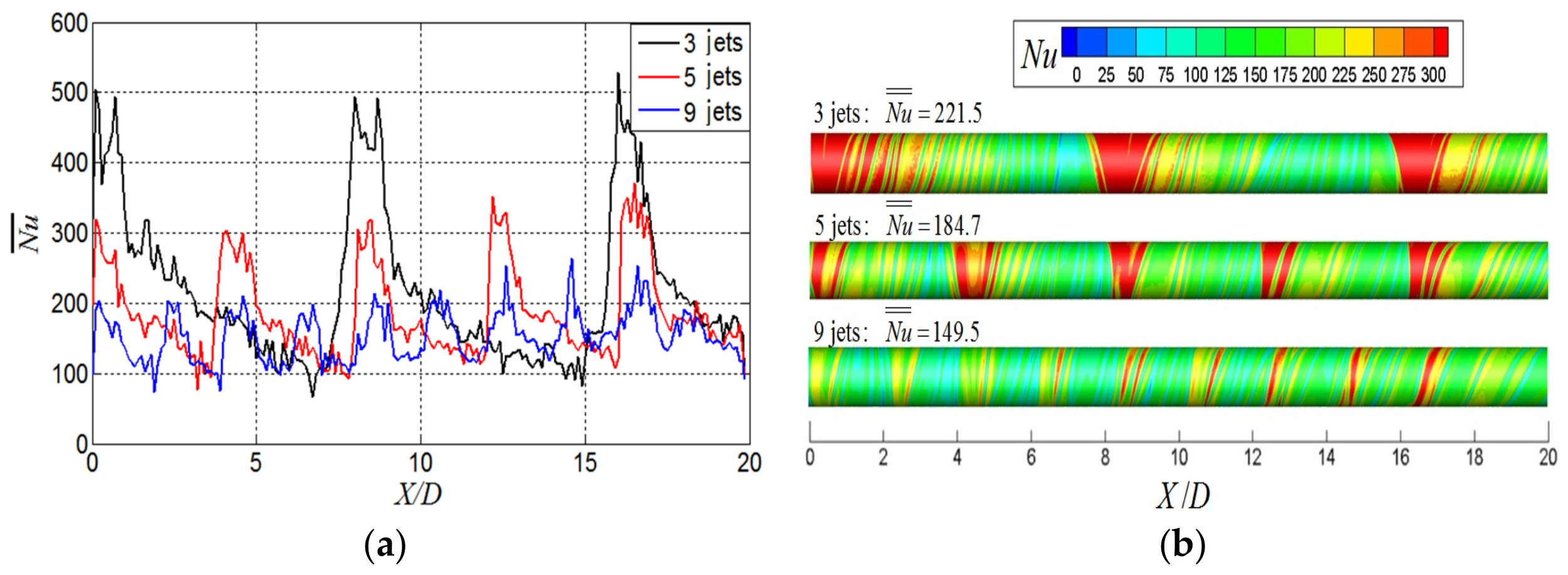

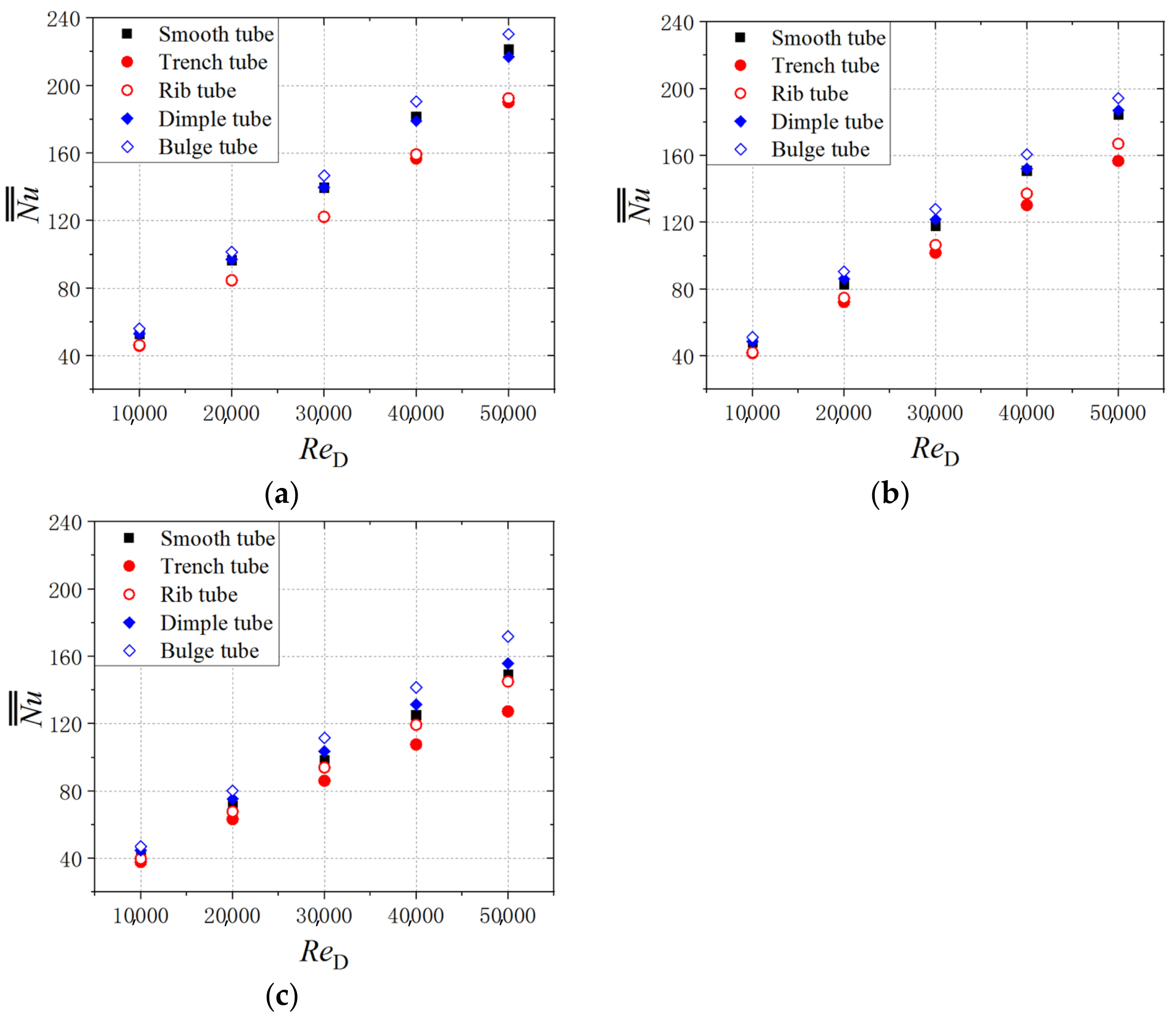
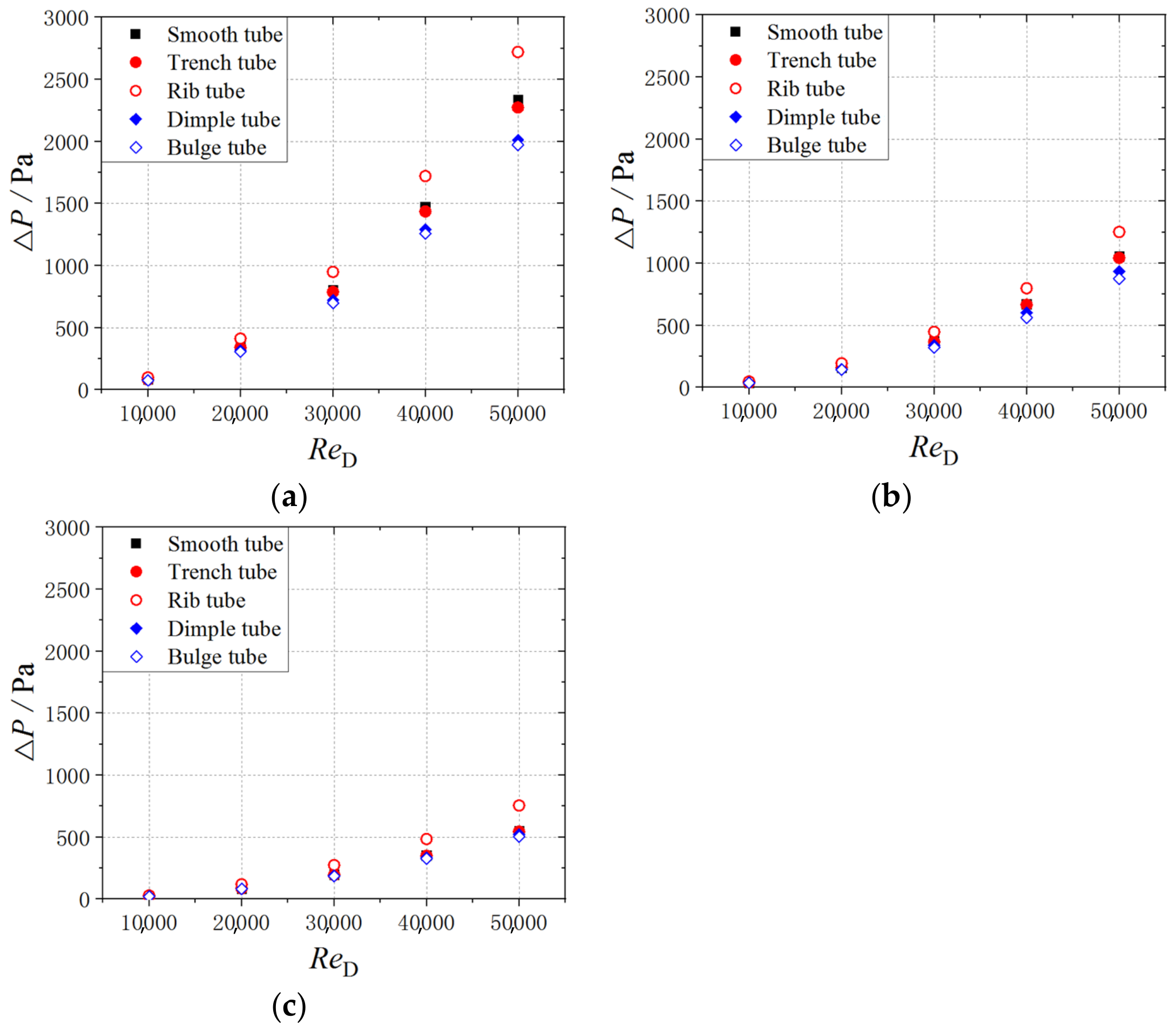
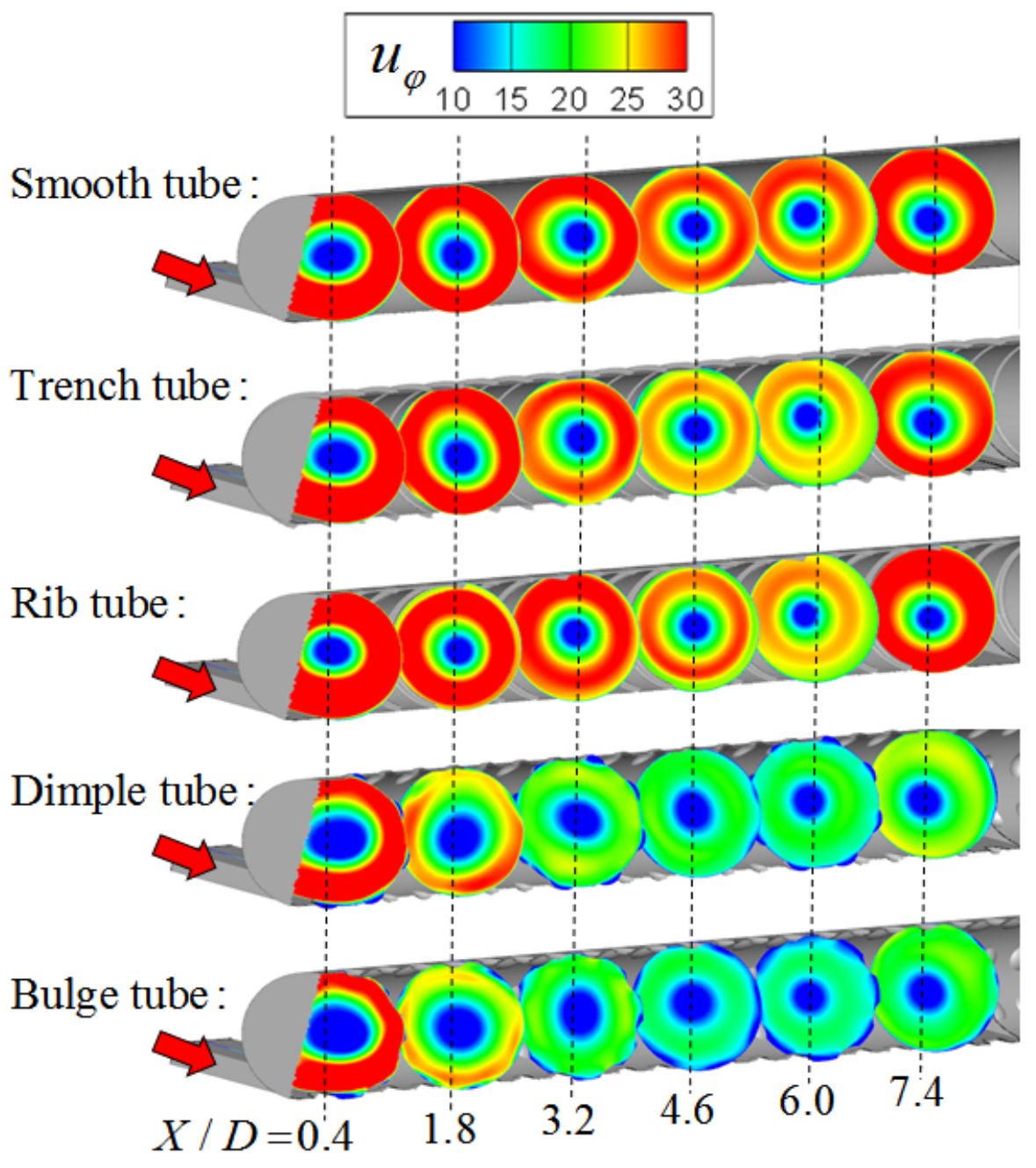
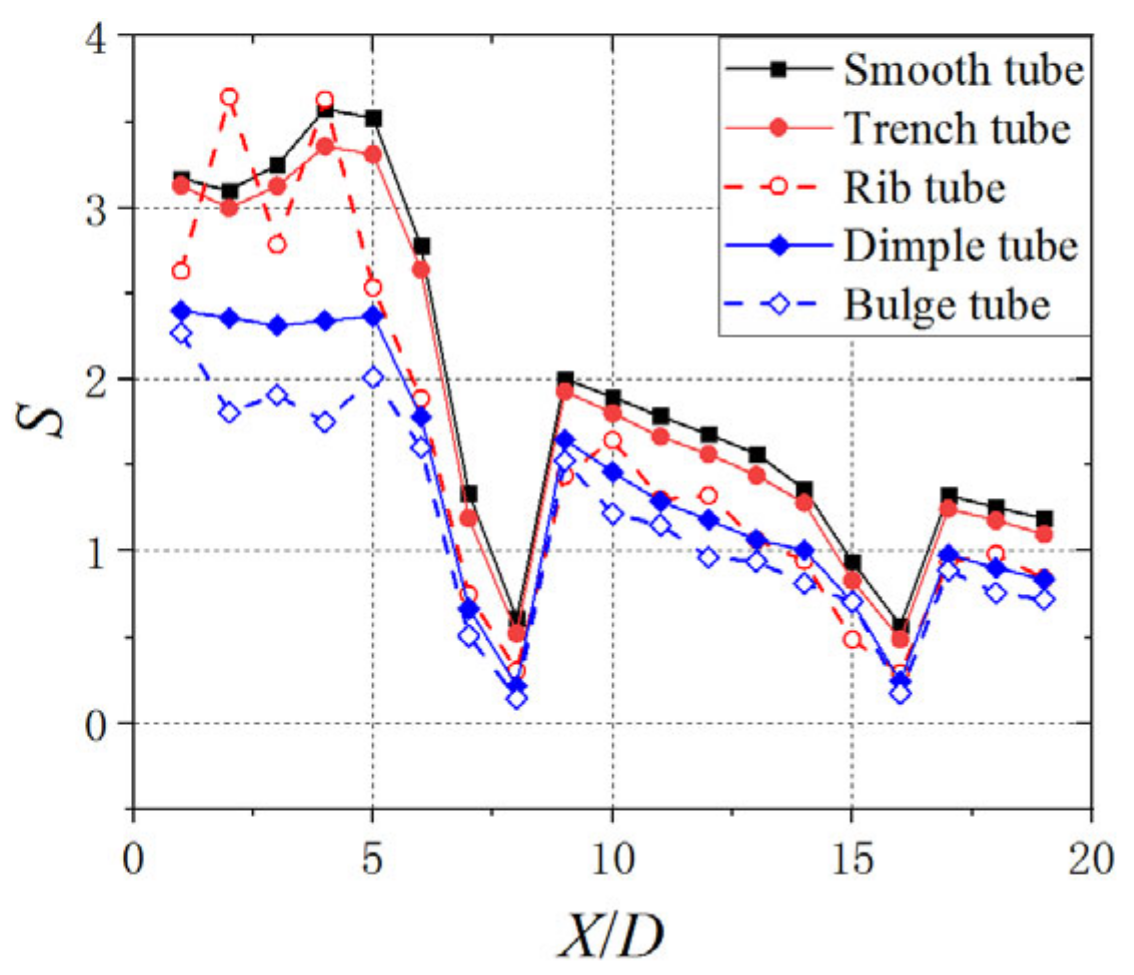
| Parameter | Value | Parameter | Value |
|---|---|---|---|
| N | 3, 5, 9 | ReD | 10,000–50,000 |
| L | 1.0 m | L/D | 20.0 |
| D | 0.05 m | LJ/D | 0.2–0.8 |
| W | 0.0333 m | W/D | 0.67 |
| H | 0.0085 m | H/D | 0.17 |
| ReD | CFD Data of Nu | EXP Data of Nu | Deviations |
|---|---|---|---|
| 10,000 | 48.3 | 42.3 | +14.2% |
| 20,000 | 83.2 | 82.0 | +1.5% |
| 30,000 | 118.0 | 122.5 | −3.7% |
| 40,000 | 151.0 | 158.4 | −4.7% |
| 3 Jets | 5 Jets | 9 Jets | |
|---|---|---|---|
| Trench tube | −14.2% | −15.1% | −14.7% |
| Rib tube | −13.1% | −9.5% | −2.9% |
| Dimple tube | −2.2% | +1.3% | +4.3% |
| Bulge tube | +4.0% | +5.3% | +15.0% |
| 3 Jets | 5 Jets | 9 Jets | |
|---|---|---|---|
| Trench tube | −2.7% | −1.3% | −1.4% |
| Rib tube | +16.4% | +18.4% | +36.9% |
| Dimple tube | −13.9% | −11.7% | −5.6% |
| Bulge tube | −15.6% | −17.1% | −8.6% |
Disclaimer/Publisher’s Note: The statements, opinions and data contained in all publications are solely those of the individual author(s) and contributor(s) and not of MDPI and/or the editor(s). MDPI and/or the editor(s) disclaim responsibility for any injury to people or property resulting from any ideas, methods, instructions or products referred to in the content. |
© 2023 by the authors. Licensee MDPI, Basel, Switzerland. This article is an open access article distributed under the terms and conditions of the Creative Commons Attribution (CC BY) license (https://creativecommons.org/licenses/by/4.0/).
Share and Cite
Liu, Y.; Luan, Y.; Dai, X.; Liu, S.; Yi, X.; Rao, Y. A Numerical Study on Swirling Hot Air Anti-Icing with Various Surface Structures on the Internal Wall. Energies 2023, 16, 1179. https://doi.org/10.3390/en16031179
Liu Y, Luan Y, Dai X, Liu S, Yi X, Rao Y. A Numerical Study on Swirling Hot Air Anti-Icing with Various Surface Structures on the Internal Wall. Energies. 2023; 16(3):1179. https://doi.org/10.3390/en16031179
Chicago/Turabian StyleLiu, Yuyang, Yong Luan, Xinbo Dai, Senyun Liu, Xian Yi, and Yu Rao. 2023. "A Numerical Study on Swirling Hot Air Anti-Icing with Various Surface Structures on the Internal Wall" Energies 16, no. 3: 1179. https://doi.org/10.3390/en16031179
APA StyleLiu, Y., Luan, Y., Dai, X., Liu, S., Yi, X., & Rao, Y. (2023). A Numerical Study on Swirling Hot Air Anti-Icing with Various Surface Structures on the Internal Wall. Energies, 16(3), 1179. https://doi.org/10.3390/en16031179






